The Evening Moon Exhibits Earthshine, Poses With Planets, and Turns its Eastern Cheek – plus An Eye on Orion!
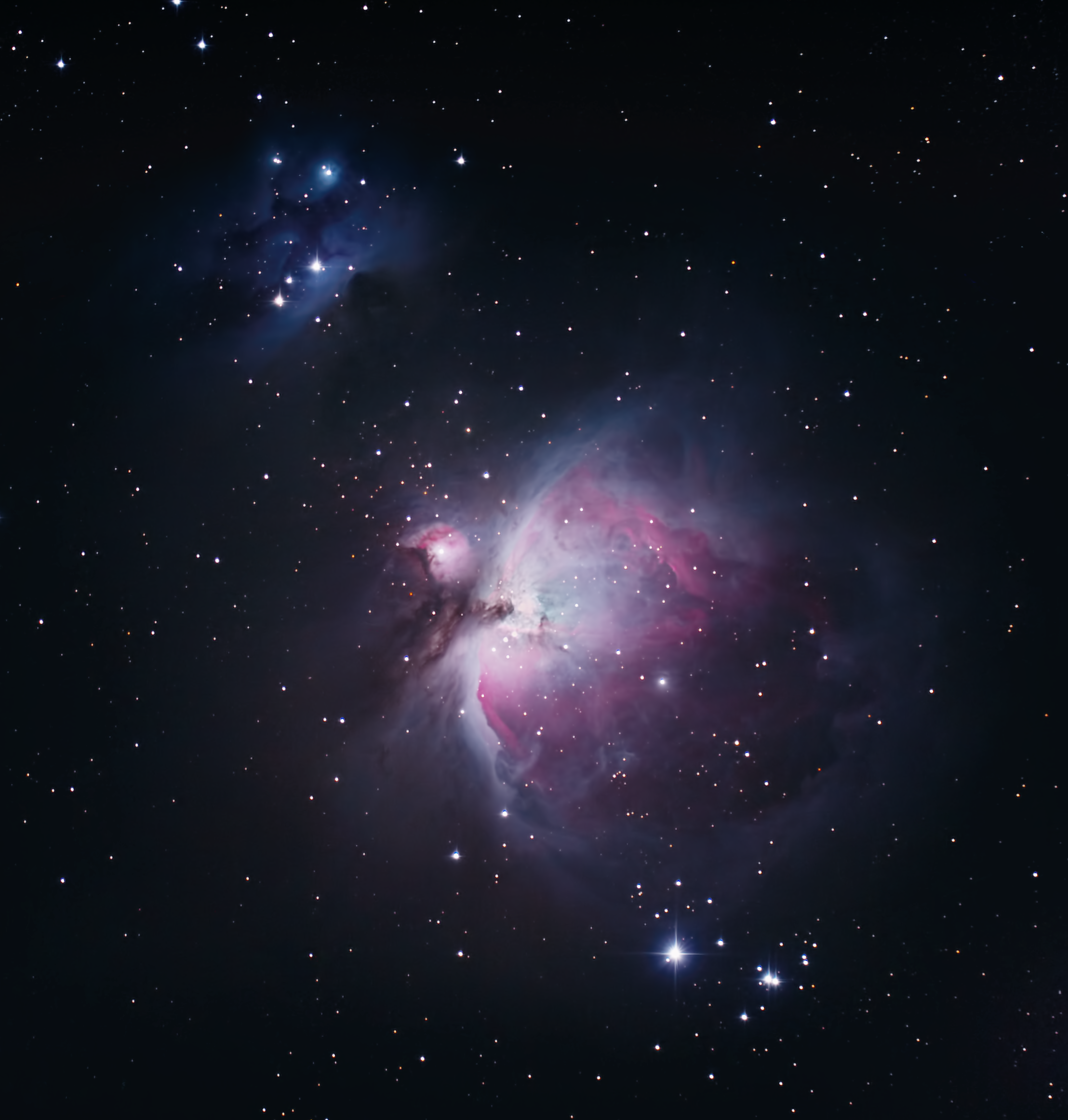
This terrific image of the Orion’s sword was taken on January 7, 2019 by Rick Foster of Markham, Ontario. Even binoculars will reveal that the central patch of light is the splendid Orion Nebula, also known as Messier 42. The grouping of bright stars at bottom right are “the Lost Jewel of Orion’s Sword”, particularly the magnitude 2.75 star named Nair al Saif, and sometimes called Hatysa, or Iota Orionis. Well above the Orion Nebula is the ghostly Running Man Nebula (Sh2-279), one the sky’s brightest reflection nebulas – composed of blue gas, darker dust, and stars in a package spanning 42 by 26 arc-minutes across. The area shown here covers about 2 finger widths of the sky.
Hello, late-February Stargazers!
Here are your Astronomy Skylights for the week of February 19th, 2023 by Chris Vaughan. Feel free to pass this along to your friends and send me your comments, questions, and suggested topics. You can also follow me on Twitter as @astrogeoguy! Unless otherwise noted, all times are expressed in Eastern Time. To subscribe to these emails please click this MailChimp link.
If you’d like me to bring my Digital Starlab portable inflatable planetarium to your school or other daytime or evening event, or deliver a session online, contact me through AstroGeo.ca, and we’ll tour the Universe, or the Earth’s interior, together! My terrific book with John A. Read entitled 110 Things to See With a Telescope is a guide to viewing the deep sky objects in the Messier List – for both beginners and seasoned astronomers. DM me to order a signed copy!
The moon will return to the post-sunset western sky this week, perfectly positioned for enjoying it with eyes, optical aids, or cameras as it poses with several planets. Brilliant Venus will slip ever closer to bright Jupiter, and Mars will shine on high in evening. Since the moon won’t bother us until late in the week, we keep an eye on Orion’s sights. Read on for your Skylights!
The Moon
After hiding near the sun for a couple of days, our natural satellite will return to visibility worldwide starting on Monday after sunset. The moon won’t become bright enough to bother stargazers until the end of this week, so take a look at winter’s best objects if you get any clear nights.
The moon will officially reach its new moon phase at 3:06 am EST, 12:06 am PST or 07:06 Greenwich Mean Time on Monday morning, February 20. By the time sunset occurs on Monday in the Americas, the extremely young crescent moon (only 0.8 days old) will be lurking just above the west-southwestern horizon for about half an hour after the sun sets. Viewing the tiniest possible sliver of moon at sunset is an item on many astronomers’ must-see lists. Sighting the young moon was also the way the start of lunar months were identified by cultures that used a lunar calendar before calculations allowed us to read printed tables or use smartphone apps!

The timing of Easter is controlled by the moon’s phases. This week’s Mardi Gras or Shrove Tuesday, and Ash Wednesday are observed 47 and 46 days before Easter Sunday, respectively, so there’s an astronomical connection to their timing, too.
Monday evening’s moon will be tough to see against the bright twilight sky, but on Tuesday, the slender crescent of the young moon will form a line below Venus and Jupiter – setting up a wonderful widefield photo opportunity in the western sky after sunset. The moon will be positioned a generous palm’s width below Venus. Watch for Earthshine. Sometimes called the Ashen Glow or the Old Moon in the New Moon’s Arms, the phenomenon is visible within a day or two of new moon, when sunlight reflected off Earth and back toward the moon slightly brightens the unlit portion of the moon’s Earth-facing hemisphere. While it won’t be easily observable while that low in the sky, the distant planet Neptune will be lurking several finger widths to the right (or 2.7 degrees to the celestial northwest) of the moon.
The moon will continue its trip past the bright planets in the western sky on Wednesday evening. In the hours after sunset, its beautiful slender crescent will shine less than a thumb’s width to the left (or 1.2 degrees to the celestial south) of Jupiter. Venus will be positioned a palm’s width below them, making another terrific widefield photo opportunity. The moon and Jupiter will be cozy enough to share the view in a backyard telescope – allowing you to see a magnified view of our moon and Jupiter’s moons at the same time! At around 23:00 GMT, observers in parts of western Antarctica, the Falkland Islands, and southern South America can see the moon cross in front of, or occult, Jupiter just before they set in evening.
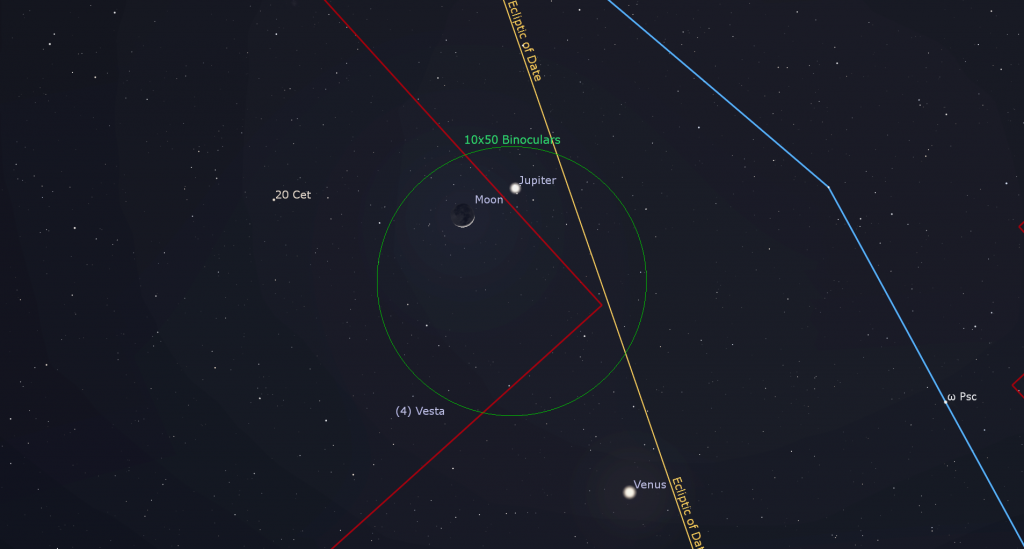
Tuesday evening onwards will also be ideal times to view the moon in binoculars and backyard telescopes at a very convenient time. As the moon’s angle from the sun increases by about 13° or 1.3 fist diameters each day, its illuminated phase increases, too. The sunlight striking the moon on the eastern side of the lunar terminator, the curved pole-to-pole boundary dividing the lit and dark hemispheres, is nearly horizontal. It casts stark, black shadows to the west of every bump, ridge, hill, crater rim, and mountain – revealing textures that are otherwise not apparent. As the terminator slips across the moon hour by hour and night after night, new strips of lunar topography are highlighted. It’s fun to check on a crater every hour or two and see it slowly fill with light. The shape of the shadow across a crater floor tells us whether it is funnel-shaped, bowl-shaped, or flat like a pie pan.
The moon’s eastward orbital motion around Earth will also cause it to set about 75 minutes later each night and carry it across the background stars. After its trip along the crooked border between Cetus (the Whale) and Pisces (the Fishes) on Wednesday and Thursday night, the moon will spend Friday and Saturday in Aries (the Ram).
On Friday night, the blue-green, magnitude 5.8 speck of Uranus will be positioned a generous palm’s width to the upper left (or 6 degrees to the east) of the waxing crescent moon. With the moon sliding east by its own diameter every hour, observers in more westerly time zones will see the moon getting closer to the planet, allowing them to share the view in binoculars. Hours later, around 12:00 GMT, observers located in the southern half of Greenland and parts of far northern Canada can see the moon occult Uranus, the last in a lengthy series of monthly occultations that occurred during 2022 and 2023. On Saturday night, the moon will hop past Uranus and shine a palm’s width above it.
Due to the moon’s 1.5° axial tilt, its orbital inclination (or tilt) of 5° from the Earth’s orbital plane, and the moon’s orbital ellipticity (or out-of-roundness), the moon nods up-and-down by up to 7° and twists left-to-right up by to 8° while keeping the same hemisphere pointed towards Earth. Over time, this lunar libration effect lets us see an extra 9% of the moon’s total surface without having to leave the ground! Lunar features that are normally smeared along the moon’s edge or completely hidden can rotate into clearer view for a few nights. The librated sector of the moon’s limb migrates clockwise around the moon over a lunar month – but librated features can only be observed if their sector happens to be bathed in sunlight at the same time.
On the coming weekend, the moon will rotate its eastern “cheek” in our direction, allowing us to see libration’s effect on the moon by noting the location of Mare Crisium “the Sea of Crises”. That’s the isolated, dark and round feature located near the right-hand (eastern) edge of the moon, just north of the moon’s equator. It becomes fully illuminated starting about four days after new moon each month. Whenever the young crescent moon is descending in the western sky after sunset, its eastern edge becomes tilted downwards, towards the lower right – making Mare Crisium a prominent dark blob positioned squarely within the illuminated crescent.
On the coming weekend, libration will shift Mare Crisium farther than usual from the moon’s edge. Once you’ve spotted it, look nearby for two dark patches positioned closer to the moon’s edge. Those are lunar basins, or maria, named Mare Marginis, which is closer to Mare Crisium, and Mare Smythii, which sits farther south and is therefore farther away from Crisium. Those “seas” are difficult to see unless the moon’s eastern limb is rotated towards Earth.

If you’ve been watching the moon throughout this week, you’ll have noticed the terminator straightening more and more. Next Sunday night it will be almost completely straight because the moon’s first quarter phase is imminent. Ancient astronomers deduced that the moon was a sphere by using the terminator’s shape. If you vary the direction that a light strikes a ball in darkened room, you can make your own terminator vary!
The Planets
Jupiter and Venus will continue to put on a terrific show in the western sky after sunset this week. Jupiter will be higher than Venus, but the distance between the two planets will be shrinking each night because Jupiter is being carried downward (sunward) with the background stars while Venus’ eastward orbital motion is moving it the opposite direction. They’ll kiss in a spectacular close conjunction on March 1. In the meantime, the waxing crescent moon will pose near them in picturesque fashion from Tuesday to Thursday, as I described above.
This week, for those living at mid-northern latitudes, the sun will set just before 6 pm in your local time zone. The length of daylight is now increasing by almost 3 minutes per day! Organizing spring star parties for younger stargazers gets tricky due to the later sunsets – and the upcoming commencement of Daylight Saving Time will make those events even later. Days lengthen and nights shorten at the greatest rate around the March equinox. (The reverse is true if you live in the Southern Hemisphere.)

You should be able to spot magnitude -3.89 Venus shining almost a third of the way up the western sky even before sunset. It will set around 8 pm local time. Viewed in a telescope, Venus will display a waning, 87%-illuminated disk. To see its shape most clearly in a telescope, look as soon as you can find it, when it will be higher and shining through less intervening air.
The magnitude -2.1 planet Jupiter will gleam a bit less brilliantly than Venus below it, and it will remain visible for about 45 minutes after Venus has sunk below the rooftops. Our window of time for clear magnified views of Jupiter in binoculars and telescopes will end in mere weeks. It’s dropping lower by a full finger’s width every two days.
Jupiter will look best in a telescope as soon as you can spot it – while it is still reasonably high. It will sink lower through the evening and set in the west around 8:40 pm local time. Binoculars should be able to show a small disk bracketed by its line of four Galilean moons named Io, Europa, Ganymede, and Callisto. Those moons complete orbits of the planet every 1.7, 3.6, 7.2, and 16.7 days, respectively. If you see fewer than four moons, then one or more of them is crossing in front of or behind Jupiter, or hiding in Jupiter’s dark shadow – or two of the moons are very close together or occulting one another. All four moons will gather below (to the west of) the planet on Tuesday evening.
Even a small, but decent quality telescope can show you Jupiter’s dark belts and light zones, which are aligned parallel to its equator. With a better grade of optics, Jupiter’s Great Red Spot, a cyclonic storm that has raged for hundreds of years, becomes visible for several hours when it crosses the planet every 2nd or 3rd night. For observers in the Americas, that GRS will cross Jupiter’s disk in early evening on Wednesday, and a little later on Sunday, Wednesday, and Friday evening. If you have any coloured filters or nebula filters for your telescope, try enhancing the spot with them.
Mars continues to be easy to see high in the sky after dusk each night. Although it is gradually dimming and becoming smaller in telescopes as Earth increases its distance from the red planet, you can still use a high magnification eyepiece to see the largest dark markings on its rusty, 8.9 arc-seconds-wide disk. If you have coloured filters for your telescope, see if the blue, orange, or red one improves the view.
At about 7 pm local time, Mars will be positioned at its highest point (and its absolute best telescope viewing time) in the southern sky. Look for it above the stars of Orion (the Hunter) and a slim fist’s width to the upper left (or celestial northeast) of the bright, reddish star Aldebaran, which marks the angry eye of Taurus (the Bull). The Pleiades star cluster will be twinkling 1.5 fist widths to Mars’ upper right (celestial west). Over the coming weeks, you’ll be able to see Mars moving eastward each night, farther from Aldebaran and the Pleiades. Mars will descend the western sky through the night and set during the wee hours.
The weak, magnitude 5.8 dot of blue-green Uranus will continue to be located nearly halfway from Mars towards Jupiter. You can also search a generous fist’s width to the left (or 12.5° to the celestial southeast) of Hamal, the brightest star in Aries (the Ram). Closer guideposts to Uranus are several medium-bright stars, including Al Butain II (or Rho Arietis), 40 Arietis, Omicron Arietis, and Sigma Arietis, which will surround the planet within the same binoculars field of view. Those faint stars mark the hooves of the Ram. Uranus will be ideally placed for telescope-viewing, high in the southern sky, immediately after dusk this week. It will set shortly after 11:30 pm.

The main belt asteroid designated (2) Pallas is currently shining with a visual magnitude of 7.9, which is within reach of binoculars and backyard telescope. Pallas will still be situated low in the southern sky after dusk, in western Canis Major (the Big Dog). It’s also binoculars-close to the bright Little Beaver Cluster (Messier 41) and the medium-bright stars Mirzam and Nu2 CMa. Its motion shown in this chart will carry it higher and closer to Sirius later this week as it gradually returns to eastward motion through the stars.
Comet Update
Comet c/2022 E3 (ZTF) is still visible in binoculars and backyard telescopes, especially without a bright moon in the evening sky. This week, Comet E3 (for short) will travel southward in the sky two finger widths to the right (celestial west) of and parallel to the up-down row of stars that form Orion’s shield.
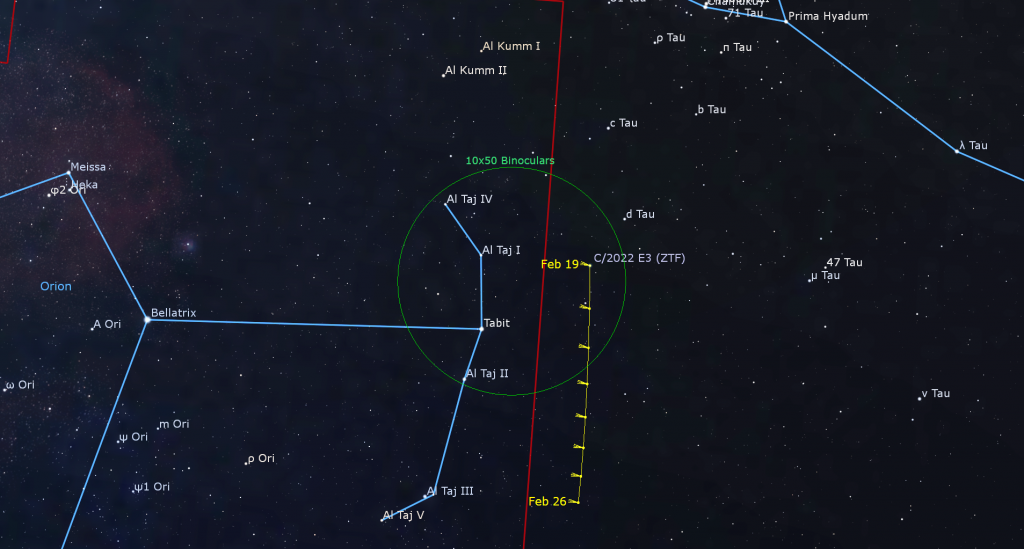
An Eye on Orion
Every year during winter, the southern evening sky is dominated by the eye-catching constellation of Orion (the Hunter) and his famous three-starred belt. Orion contains some of the sky’s most spectacular sights – whether you are using your unaided eyes, binoculars, or telescopes of any size! Orion’s spectacular stars, and the bright nebulas in his sword and belt, make cold winter nights much more rewarding for skywatchers. So let’s bundle up against the winter chill and take a tour of the hunter!
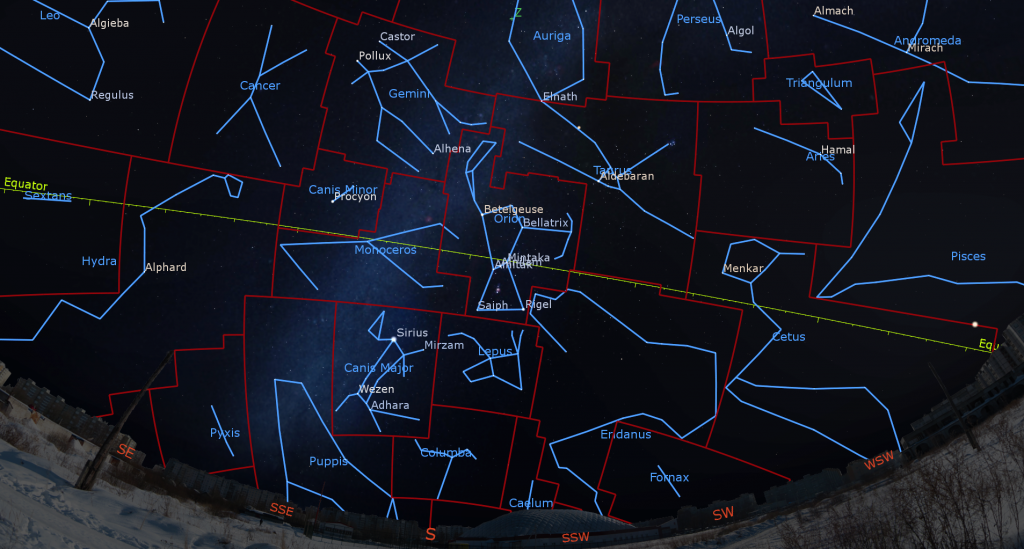
The constellation of Orion is well-known for several reasons. It straddles the Celestial Equator, making it visible from both the Northern and Southern Hemispheres. Most of its stars are bright enough to see with unaided eyes, even under light-polluted skies. And the constellation obviously represents a human figure.
Orion is surrounded by Taurus (the Bull) to his upper right (celestial northwest), Gemini (the Twins) to his upper left (northeast), Monoceros (the Unicorn) on his left (east), Lepus (the Rabbit) below him (south), and Eridanus (the River) towards his lower right (southwest).
He has traditionally been depicted as kneeling. His eastern arm is raised and holds a club. His western arm is outstretched, and his hand holds a lion’s pelt, or a shield. Orion is a medium-sized constellation measuring about 30° (or three outstretched fist widths) from the tip of his club to his toes or knees, and 20° from his eastern elbow to the lion’s pelt. In early evening in late February, Orion is halfway up the southern sky, his head tilted a little to the right for observers viewing him in the Northern Hemisphere. As the evening wears on, Orion drops lower and tips over more, then he sets at about 1:30 am local time.

The constellation was recorded by Babylonians as the Heavenly Shepherd (where his club is a crook). The Egyptians added the stars of Lepus to form the god Sah, which was associated with the deity representing the star Sirius. The muslims called him “al-jabbar” the giant. The Polynesians saw a Cat’s Cradle game in Orion’s stars. The Maori incorporated Orion’s belt into the stern of their great ocean-going canoe, Te Waka O Tamarereti.
In Greek mythology, Orion was Prion the hunter, the son of Poseidon. When Prion threatened to hunt and kill all the animals in the world, Earth-mother Gaia sent Scorpius to sting him to death. But Ophiuchus (the Water-Bearer) used medicine to save Prion. Now, Orion and Scorpius sit on opposite sides of the sky. Orion is in the winter evening sky and Scorpius is in the winter morning sky – with Ophiuchus stepping on the scorpion from above. Orion is mentioned several times in the Bible, and as Menelvagor “the Swordsman of the Sky” in J. R. R. Tolkien’s Lord of the Rings.

The Ojibwe and related indigenous groups of North America associate Orion’s stars with the constellation of Biboonikeonini (”Bih-BOON-koh-nih-NIH”), the Winter-Maker. They envision him with longer arms – so that his hands hold the bright stars Procyon on the east and Aldebaran on the west.
Not surprisingly, many cultures have also assigned meaning to the distinctive row of three regularly spaced stars that mark Orion’s Belt. Scandinavian countries have seen a distaff, a scythe, and a sword. Predominantly Catholic countries referred to those three stars as The Three Mary’s (as featured in the New Testament). In the Middle East, his belt has been identified as The Three Kings or Magi. In China, it is known as The Weighing Beam and the Three Stars. In fact, the top portion of the Chinese character, 參 (shēn) has three identical symbols representing those three stars. The Lakota people called his belt the Bison’s Spine – with surrounding stars and nearby constellations forming the rest of a great bison in their winter sky. When viewed from the Southern Hemisphere, Orion is upside-down. His belt and sword combine to form the shape of a frying pan! Try bending over and looking at him upside-down.
From left to right (or east to west in the Northern Hemisphere), the three belt stars are named Alnitak, Alnilam, and Mintaka. While they appear similar, Alnitak is bluer, Mintaka is dimmer, and Alnilam is MUCH farther away.
In a telescope, Alnitak (Arabic for “the Girdle”) is revealed to be a very tight double star. The larger, main star of Alnitak’s pair is a blue supergiant star located about 820 light-years from our solar system. The star emits tremendous amounts of ultraviolet light. Its surface temperature is a scorching 31,000 Kelvins, which is essentially the same as 31,000° C at those extremes! For comparison, our little yellow sun’s temperature is a mere 6,200 K! Alnitak’s dimmer partner is orbiting the main star once every 1,500 years!
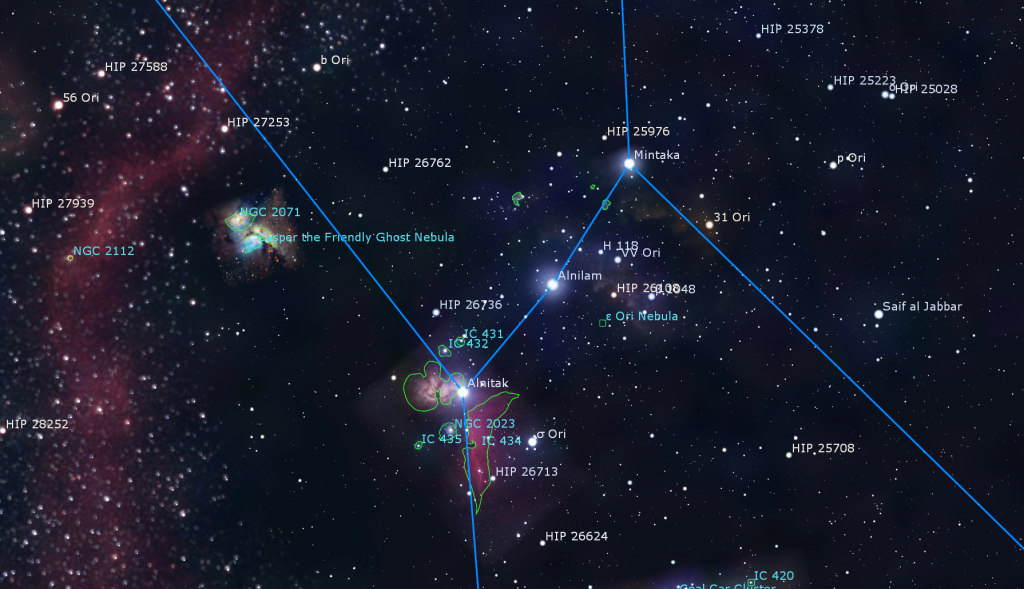
The belt’s middle star, Alnilam (“String of Pearls”), is another large and very hot, blue-white star. It’s located about twice as far away from us than the two other belt stars. Aging rapidly and nearing the end of its hydrogen supply, Alnilam is expected to become a red supergiant, the pre-cursor to a supernova blast, at any time. And since the star is more than 1,900 light years away from us – that explosion may already have happened!
The belt’s westernmost star, called Mintaka (“Belt”), is also a double star when viewed in a telescope. In fact, there are at least four stars making up what we see as Mintaka. The brightest one has a partner that orbits it in an eclipsing binary configuration that causes the star to vary in brightness for 18 hours every 5.73 days. The dominant stars in Mintaka’s family gathering are hot, blue giants. The group is located about 900 light years away from our solar system. If you look carefully, Mintaka is actually quite a bit dimmer than Alnitak and Alnilam. At the same time, look for a large, upright letter-S shape composed of dim stars in the space between Alnilam and Mintaka.
The bright, orange-coloured star named Betelgeuse marks Orion’s eastern armpit or shoulder. That funny-sounding name comes from the Arabic expressions “Ibṭ al-Jauzā”, meaning “the Armpit of Jauza”, or “Yad al-Jauzā”, “the Hand of Jauza”. Jauza was the Arabic name for the person the Arabs saw depicted in the Orion constellation. In Chinese, Betelgeuse is called 参宿四 Sānsù Sì, which translates to “The Fourth Star of the constellation of Three Stars”.
Betelgeuse is a red supergiant star located about 500 light-years away. If Betelgeuse replaced the sun in our solar system, all the inner planets out to Mars would be inside the star! Despite an age much less than our sun (it is of a type that matures dramatically faster), astronomers think Betelgeuse is approaching the end of its life. It is massive enough to explode as a Type II Supernova.
Normally, Betelgeuse ranks as the ninth brightest star in all the night sky. But in the winter of 2019-2020 it dimmed dramatically. While Betelgeuse has been known to dim and brighten throughout the many years that astronomers have been recording its brightness, this recent dimming was far below what is typically observed. Some thought we might be seeing indications that the end is near. After several months, it recovered most of its brightness. Astronomers now theorize that an encircling cloud of opaque dust temporarily passed in front of the star, dimming its light. Since it takes about 500 years for light to reach us from Betelgeuse, it could already have exploded! If it does blow up, Earth is in no danger. We’ll just be treated to a spectacularly bright point of light for days or weeks.
The hot blue star sitting to the lower right (or southwest) of Orion’s belt is Rigel. Despite being located much farther away from us (about 860 light-years), Rigel is usually approximately the same visual brightness as Betelgeuse – meaning that Rigel emits considerably more visible light than Betelgeuse. Astronomers call this phenomena high luminosity. Rigel, too, is a supergiant star, and it has a surface temperature of 11,000 K! In a good telescope, a small companion star can be spotted very close beside Rigel. In Arabic, Rigel means “the Foot of the Great One”. In China, Rigel is known as 参宿七 (Sānsù Qī), “The Seventh of the Three Stars”.
Orion’s western shoulder is marked by the bright star Bellatrix, which translates as “Amazon Star”, after the warrior women of legend. Bellatrix is about 250 light years away from us, and burns at a blistering hot 21,500 K. It, too, is well along in its life cycle, and is expected to soon enter its next phase of evolution and turn an orange colour.
Above and between Orion’s shoulders is an open cluster of stars, 1,305 light-years distant, that forms his head. The brightest star in the group is named Meissa (“the Shining One”). Use binoculars or a telescope to enjoy them better, and see how many stars you can count. And try to magnify Meissa more to see its close partner. Some star charts call the cluster the Lambda Orionis Cluster, after Meissa’s Bayer designation.
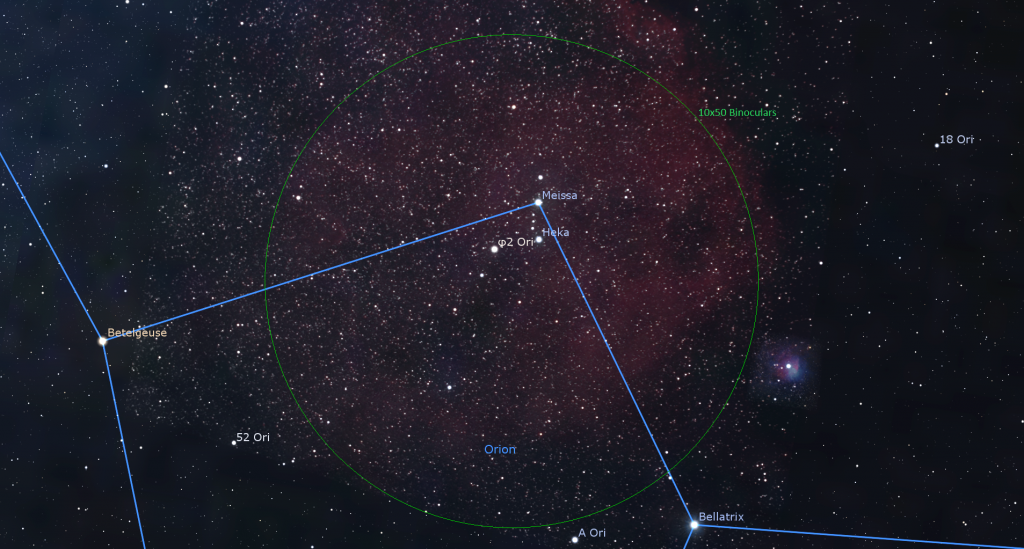
Completing our circuit of Orion’s main body, the western foot or knee of Orion is the mis-named star Saiph or “Sword of the Giant”. Saiph is another hot, blue white star, with a surface temperature of 26,500 K, and it is also approaching the transition to creaky, old, red supergiant.
The lion’s pelt, or shield, that Orion is holding is composed of a crooked line of stars that run up and down off to Orion’s right-hand (or western) side. The brightest star, in the middle of the string, is named Tabit (“the Endurer”). This star’s Bayer designation is Pi Orionis. In fact, the entire set of stars are named π1 through π6 Orionis.
On the opposite side of the constellation, Orion’s upraised club dips into the Milky Way. As you move up the club, the pairs of stars that define it move wider apart. Use your binoculars to reveal the rich Milky Way star fields there.
We can use Orion’s stars as pointers to other ones. Extending the belt stars to the west leads to the bright, orange-ish star Aldebaran in Taurus, the Bull. Heading two fist diameters in the opposite direction leads you to the “Dog-star” Sirius, the brightest star in the entire night sky. A line drawn from Bellatrix to Betelgeuse points to Sirius’ bright puppy, the star Procyon. Finally, the line extending from Rigel up through Betelgeuse leads to the two matched stars Castor and Pollux, the heads of Gemini (the Twins).
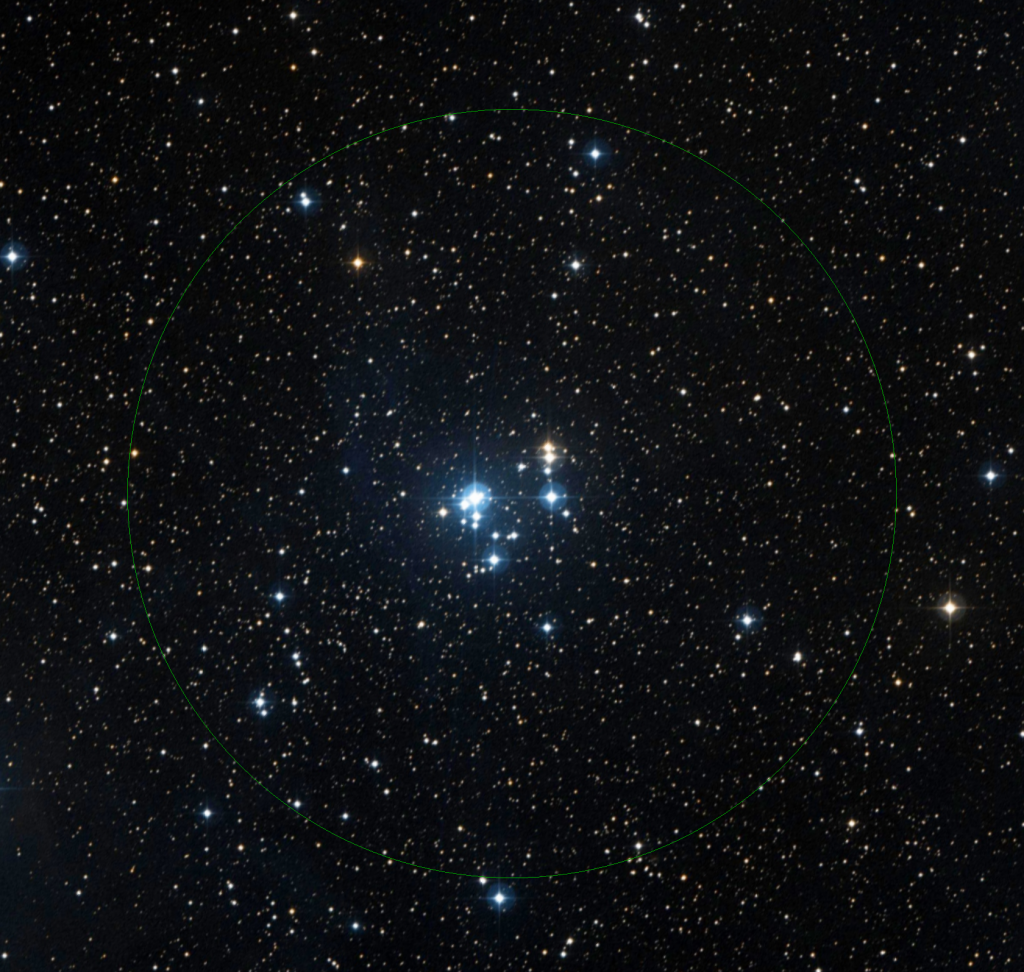
Orion’s spectacular sword is one of winter’s true astronomical treats. The sword is located a few finger widths below Orion’s belt. Unaided eyes can generally detect three patches of light in Orion’s sword, but binoculars or a telescope will reveal that the middle object is not a single star at all, but a bright knot of glowing gas and stars known as The Orion Nebula (or the Great Nebula in Orion, Messier 42, and M42).
The Orion Nebula is one of the brightest nebulae in the entire night sky and, at 1,400 light-years from Earth, it is one of the closest star-forming nurseries to us. It’s enormous. Under a very dark sky, the nebula can be traced over an area equivalent to four full moons! When you see knots of pink color in photos of other galaxies, you are seeing objects like M42.
Buried in the core of the Orion Nebula is a tight clump of stars collectively designated Theta Orionis (Orionis is Latin for “of Orion”), but better known as the Trapezium – because the brightest four stars occupy the corners of a trapezoid shape. Even a small telescope should be able to pick out this four-star asterism – but good seeing conditions and a larger aperture telescope will reveal two additional faint stars in the trapezium. The trapezium stars are hot, young O- and B-type stars that are emitting intense amounts of ultraviolet radiation. The radiation causes the Hydrogen gas they are embedded within to shine brightly as red light. At the same time, some of their light is scattered by surrounding dust, producing blue light. The combination of red and blue is why there is so much purple and pink in colour images of the nebula.
Within the nebula, astronomers have detected many young (about 100,000 years old) concentrations of collapsing gas called proplyds that should one day form solar systems. These objects give us a glimpse into how our own sun and planets formed.
Stargazers have long known about the trapezium stars in the nebula’s core, but detection of the nebulosity around them required the invention of telescopes in the early 1600’s. In the 1700’s, Charles Messier and Edmund Halley (both famous comet observers) noted the nebula in their growing catalogues of “fuzzy” objects. In 1880, amateur astronomer Henry Draper imaged the nebula through an 11-inch refractor telescope, making it the first deep sky object to be photographed.
In your own small telescope, you should see the bright clump of trapezium stars surrounded by a ghostly grey shroud, complete with brighter veils and darker gaps. More photons would need to be delivered to your retina before colour would be observed, so try photographing it through your telescope, or using a camera/telephoto lens combination mounted on a tripod. Visually, start with low magnification and enjoy the extent of the cloud before zooming in on the tight asterism. Can you see four stars, or more? Just to the upper left of M42, you’ll find Messier 43, a separate lobe of the same nebula that has been separated by a band of opaque foreground dust. M43 surrounds a naked-eye star named nu Orionis (or ν Ori).
While you’re touring the sword, look just below the nebula for a loose group of stars, located 1,300 light-years away from Earth, called Nair al Saif “the Bright One of the Sword”. The main star is a hot, bright star expected to explode in a supernova one day. It, too is surrounded by faint nebulosity. Astronomers believe that this star was gravitationally kicked out of the Hyades Cluster in Taurus about 2.5 million years ago.
Sweeping down the sword and toward the left (east) brings us to a star named Mizan Batil ath Thaalith (or d Orionis or 49 Orionis) at the tip of the sword. This magnitude 4.7 star is near the limit for unassisted visibility under moonless, suburban skies. About two finger widths to its right is another star of similar brightness, named Upsilon Orionis, or u Ori.
Moving upwards towards Orion’s belt, look half a finger’s width (or 30 arc-minutes – equal to the full moon’s diameter) above the Orion Nebula. Here you’ll find another clump of stars dominated by c Orionis and 45 Orionis. A larger telescope, or a long-exposure photograph, will reveal a bluish patch of nebulosity around them that contains darker lanes forming the shape of a figure, called the Running Man Nebula (NGC 1977). This is another case of dust and gas scattering blue light from those two stars.
Just above the Running Man sits a loose cluster of a few dozen stars called the Coal Car Cluster, or NGC 1981. It’s best seen in binoculars. Next, we jump higher – most of the way towards Alnitak, the eastern-most (left-hand) belt star, to check out a beautiful little grouping of stars collectively called Sigma Orionis (σ Ori). What makes this a special treat is that, in a small telescope, we find about 10 stars the grouping. Check it out with your telescope – trust me, it’s a pretty sight! It’s a bit more than a finger’s width to the lower right of Alnitak.
Astrophotographers love to image the area around Alnitak because it sits just to the west (or right-hand side) of the Milky Way, and is loaded with gorgeous gas clouds and nebulae. Alnitak and the brighter stars around it all host reflection nebulas – dim bluish haloes caused by starlight scattering off of dust.
Immediately below (south of) Alnitak is the famous Horsehead Nebula (or NGC 2023). It’s a cloud of hydrogen that is being energized by radiation from Alnitak, producing an elongated wedge of red light in long exposure images. A foreground patch of opaque dust that forms a delightful sea-horse or chess-piece shaped silhouette on the nebula’s (left-hand) eastern edge. It’s not readily visible – unless you have very dark skies and a very large aperture telescope.
Just to the left of Alnitak is another object called the Flame Nebula, also known as the Maple Leaf Nebula, Burning Bush Nebula, and NGC 2024. More energetic radiation from Alnitak is causing gas to glow. But this time, there’s a lot of dark dust mixed in, producing a unique shape.
Several bright emission nebulas are clumped about two finger widths to the upper left (or celestial north) of Alnitak. The brightest of these is Messier 78, the Casper the Friendly Ghost Nebula. The young stars buried within the gas and dust are producing the pinkish emissions and bluish reflections. Another similar object called the Monkey Head Nebula (or NGC 2175) sits way up beside the tip of Orion’s club.
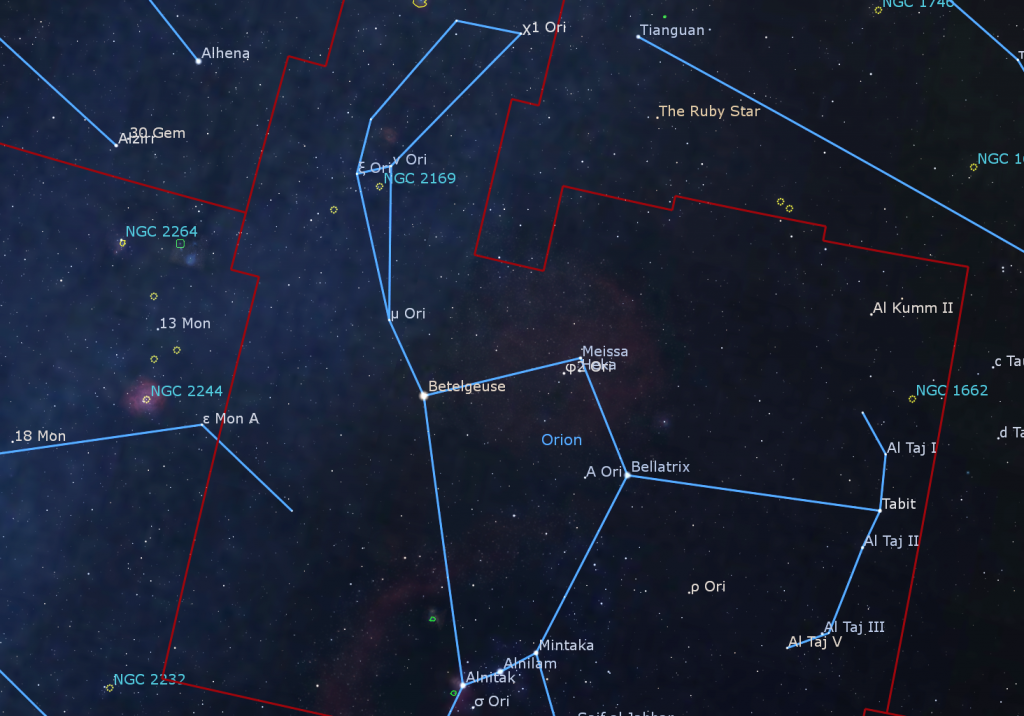
Orion’s upraised club starts at reddish Betelgeuse, continues through medium-bright Mu Orionis, and then widens north of the magnitude 4.5 stars Xi and Nu Orionis. A delightful open cluster named NGC 2169 is positioned between those stars, but offset a little towards Betelgeuse. Shining at magnitude 5.9, the cluster might look like a double star in your binoculars. In any size of telescope look for a dozen stars sparkling within a compact area. They are arranged in two groups that appear to form the letters “LE” or the number “37” or a shopping cart. Your own impression may depend upon how your telescope orients the cluster. I noted several doubles and some nice variation in the star colours.
A very nice open cluster designated NGC 1662 is located a thumb’s width to the right (or 1.6° to the celestial WNW) of Pi1 Orionis, the top star in Orion’s shield. The magnitude 6.4 cluster should be visible as a small patch in 10×50 binoculars. In any size of telescope, look for a tiny, diamond-shaped asterism flanked by a row of blue and yellow stars. It resembles a bird riding an air current, or maybe the lights of a Klingon battle cruiser. No danger, though – it’s 1,450 light-years away from our sun.
I think you’ll agree that Orion is indeed a celestial treat for everyone to enjoy!
Auriga the Charioteer
If you missed last week’s detailed look at Auriga (the Charioteer), I posted it here.
Public Astro-Themed Events
Every Monday evening, York University’s Allan I. Carswell Observatory runs an online star party – broadcasting views from four telescopes/cameras (weather permitting), answering viewer questions, and taking requests! Details are here. They host in-person viewing on the first clear Wednesday night each month. On Wednesdays they stream views online via the observatory YouTube channel. Details are here.
RASC’s has resumed Public sessions at the David Dunlap Observatory – but they are still offering several online programs from home. The modest fee supports RASC’s education and public outreach efforts at DDO. Only one registration per household is required. Prior to the start of the program, registrants will be emailed the virtual program link.
On Saturday night, February 25 from 7:30 to 9 pm EST, tune in for DDO Up in the Sky. During the family-friendly session, RASC astronomers will live-stream views through their telescopes and the giant 74” telescope at DDO (pre-recorded views will be used if skies are cloudy). Only one registration per household is required. Deadline to register for this program is Wed., Feb. 22, 2023 at 4 pm. Prior to the start of the program, registrants will be emailed the virtual program links. More information is here and the registration link is here.
On Sunday afternoon, February 26 from 12:30 to 1 pm EDT, tune in for DDO Sunday Sungazing. Safely observe the sun with RASC, from the comfort of your home! During these family-friendly sessions, a DDO Astronomer will answer your questions about our closest star: the sun! Learn how the sun works and how it affects our home planet. Live-streamed views of the sun through small telescopes will be included, weather permitting. Only one registration per household is required. Deadline to register for this program is Wednesday, Feb. 22, 2023 at 3 pm. Prior to the start of the program, registrants will be emailed the virtual program links. More information is here and the registration link is here.
My free, family-friendly Insider’s Guide to the Galaxy webcast with RASC National returns on Tuesday, February 28 at 3:30 pm EST. With the moon waxing in the evening sky, this is the perfect time to watch the terminator slide across the giant and ancient lunar basin of Mare Imbrium. We’ll highlight the basin’s geology and showcase Imbrium sights to see with unaided eyes, through binoculars, and in telescopes of any size. Then we’ll highlight the next batch of RASC’s Finest NGC objects. You can find more details and the schedule of future sessions here.
Keep looking up, and enjoy the sky when you do. I love questions and requests. Send me some!